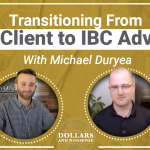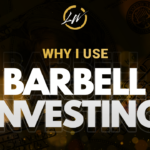In this episode, we discuss the new changes to the IRS rules on designing life insurance policies and how those changes impact the infinite banking concept.
New IRS rules will impact how life insurance companies can create new policies and contracts. Are you prepared? Tune in for an easy-to-understand breakdown of what you need to know.
Topics Discussed:
- Basics of IRS code as it relates to whole life insurance
- The goal of IBC
- Using is life insurance policies with mutual paying companies
- A brief history of life insurance
- The impact of Section 7702 of the Internal Revenue Code
- Understanding the modified endowment contract (i.e., MEC)
- What happened with a base guaranteed interest rate of 4%
- Cash values vs. death benefits
- The “big change is coming,” marketing tactic tickling some ears
- Increasing the flexibility and consumer-friendly nature
Episode Resources:
-
- Gain access to our Secret Banking Masterclass now FREE to listeners of the podcast here now
- What is Infinite Banking
- Who was Nelson Nash?
- CREDIT: Episode art background photo by Anastasia Petrova
Transcript for Podcast Episode 131 – New IRS Rules Impacting the Infinite Banking Concept
Nate:In this episode, we discuss the new changes to the IRS rules on how life insurance policies can be designed and how those changes impact the infinite banking concept. She’sHolly, and she helps people find financial freedom.
Holly:He’s Nate, he makes sense out of money. This is Dollars andNonsense, If You Follow the Herd, You Will Be Slaughtered.
Nate: All right. Well, welcome back to the show today. We’ve got an interesting topic to discuss based on some news that came out end of last year, and what’s come out is essentially some changes to the IRS rules on how life insurance companies can create new life insurance policies, new contracts, and so we’re going to talk about that. There maybe some of you listening to this podcast who are kind of new, and this whole thing… I mean, if you are brand new to this way of thinking with the infinite banking concept and using life insurance, I honestly would suggest you go back and watch other episodes and really get that down in your head before you come to this, because this is going to be a little bit more technical to some degree. But I do think it was worth a discussion, even on this show, typically doesn’t dive into some of the technicalities of life insurance and how it’s constructed and certain things. So we’re going to do that today. We’re going to try to shine some light on these changes to the IRS Code, the Internal Revenue Code, as it relates to life insurance and how that actually will change what life insurance companies can do when they build new policies and if that’s going to impactIBC, how we think it’s going to. So I guess that’s where we’re at, Holly. Anything you want to add as we kind of dive in?
Holly: The one thing I do want to convey is it’s what insurance companies could do, not necessarily what they will do. We shouldn’t operate in fear or out of fear to make those decisions. So the goal, really, behind this is just to shed light on what could happen, and that changes could happen and what it means or what it might not mean. Life insurance can change this year, next year, in the future. So really, what we’re really talking about and the goal of this is the system of Infinite banking Concept is the key here, and the tool that we’re using is life insurance policies with mutual paying companies.
Nate: Yeah. Well, I agree. I mean, I guess we could go all the way back to the 1980s. The 1980s, or prior to the 1980s, life insurance was the wild, wild west as far as there was no rules on how insurance companies could build out these policies. So people were buying policies where they were stuffing huge amounts of premium in for tiny little death benefits. So almost all of the premium would go to cash value, and a tiny little bit of it would go to death benefit. The policies were growing tax-free then as they are today, they weren’t taxed, so all these wealthy people were getting away with just pounding huge amounts of money into policies, getting all this guaranteed tax-free growth on them. And the IRS says, “This is obviously… You’re not buying this because you want life insurance, you’re just using this as an investment tool that you get tax-free growth on.”
So they came out with some rules, is really what they did. We know those, in the common vernacular, you may have heard these around the MEC rules, modified endowment contract rules, it is Section 7702 of the Internal Revenue Code, deals with the taxation of life insurance. And essentially they say, “Hey, if a life insurance company wants to build a policy that doesn’t follow these rules that we’re going to set forth that we think are fair, we’re not going to call it life insurance anymore. We’re going to create this new term called a modified endowment contract, or a MEC, and that thing’s going to be taxed differently.” So all these life insurance companies in the late 1980s had to change and come together and follow these IRS rules. So part of that rule was the IRS said that whenever you compute the values in this contract, that would be like the guaranteed cash values and the guaranteed death benefits inside of a contract, you cannot choose an interest rate that’s used to compute these values that’s less than 4%.
So they went out and said, “Hey, you can use any interest rate you want to compute the future death benefit payouts, and the guaranteed cash values and stuff and so forth, but it can’t be less than 4%.” And the reason that they did that was because it goes back to that whole idea that if an insurance company was going to use like a 1% rate or something tiny, or even lesser than that, what that would actually mean is that the death benefit when you bought the policy would start out very tiny, because the interest rate that’s used to compute this future death benefit that’s going to be paid out is so low that, I mean, the death benefit would be almost nonexistent.
So it wasn’t to be consumer-friendly that they did that. It was mainly a way to say, “Hey, life insurance companies, we don’t want you to use some phony little tiny interest rate to compute the values of this death benefit and this policy and then be able to pay out gigantic dividends to your policy holders subsequently.” So I hope we’re going to make this as clear as possible, Holly. I feel like I’m already muddying the waters, but I’m going to keep going. I’m going to keep going. [crosstalk 00:05:17].
Holly: Okay. Keep going. But one of those notes there, you have to understand, most of the time the IRS is not on your side.
Nate: And the reason I had to bring that up, by the way, the non-consumer-friendly, is because I’ve heard in infinite banking communities and with my own clients and so forth, they hear about this magical 4%, this guaranteed interest rate of 4%, as if the insurance companies all came together and said, “We’re going to be super consumer-friendly and guarantee 4%.” That’s actually not where that number came from. It came from the IRS trying to force insurance companies to do certain things with these policies that actually was not necessarily consumer-friendly.
It was actually going to end up hurting the consumer in some degree by limiting how much money has to go to the death benefit and limiting how much money can go to cash value. And that’s where you’ve got this whole MEC concept, where it limits how much premium can be added into a policy at whatever death benefit level that that policy has. If you’re going to go buy a million dollars of death benefit, let’s say, there’s what’s called a MEC premium on that. We can’t add more premium into the policy than what this MEC test would allow us to do. So all of that was started back in the 1980s. It hasn’t changed since. It’s just been the same since the 1980s.
Holly: A lot of people, Nate, are getting so focused on this. Well, the insurance company could do this. So that magic number of four, like Nate said, it’s not a magic number. It was mandated, right? So just like this new law, it’s what they could do, they don’t have to.
Nate: The IRS is allowing insurance companies to write policies that are not at a floor of four anymore. They actually are going to allow them to create new policies that have a lower guaranteed value. They can actually go all the way down to 2% now, so that’s kind of where we’re going. But what I wanted to bring this up to say was it hasn’t been changed. Since the 1980s, there’s been this floor of 4%. And if an insurance company wants to build a policy that has less than 4% interest rate used to compute the values, it will violate the MEC rules because too much money inside that contract would be devoted to cash value and too little would be devoted to the death benefit. So it would violate the MEC rules that they just set up back then.
Well, the problem was today’s day and age, is people are like, “Well, the interest rate environment, the insurance companies are saying the interest rate environment’s so low, they’ve been lobbying to get a change done,” because really what they’re seeing is as interest rates are lower, the dividends are being reduced, and they wanted a way to still be able to put forth really high cash value policies, but that MEC test was actually causing them to be limited in what they could do. The 4% rule was built back when interest rates for CD accounts were like 10% in the ’80s. So it’s just like a lot of things have changed, like we ought to be able to have more flexibility.
And I guess, Holly, where we’re going with this is I knew a few of my clients heard about this before, they’ve talked to me. A lot of people come in thinking that the IRS now allowing insurance companies to create brand new policies, by the way, this has nothing to do with your existing policies, all of you who’ve got policies, there’s no change to those. This is just saying an insurance company is now allowed, if they want to, to create a new policy that has a lower than 4% interest rate used to compute its values. And I feel like when that news broke, some people panicked. They thought that the policies were going to be really bad in the future. Like, “Oh, suddenly if my policy’s not guaranteed to grow at four, but it’s only guaranteed to grow at three or two or something, that suddenly this policy is not as good.”
And really, I guess, what Holly and I wanted to get across here, by the way, was first off, that’s actually not the case. That’s not actually what’s happening. Your policy does not only grow with guaranteed cash value. What we’ve been told from the very beginning by the insurance companies, and now some of them are coming out with new policies and we’re seeing this, is that really what happens when an insurance company reduces the interest rate that’s used to compute the values, if they reduce it, that means that the initial death benefit will be significantly less. The guaranteed cash value will be less as well. But the dividends on that same policy with the same amount of premium that we used to pay are going to be significantly higher. So what they told us all to expect was that the values of a policy, when you include the dividends, may actually end up being higher, in fact, probably will be higher, under the new policies.
You can’t actually even go out and buy one yet from a mutual dividend bank. There’s no one out there who has them out yet, but we’re allowed to see a few, or they send information about a few, and that’s exactly what’s happening. The guaranteed values are being reduced, and it’s not even a huge reduction. It’s kind of a slight reduction. And the non-guaranteed values on a few of them are higher. Some of them, the non-guaranteed values, which are the values they include with the dividends, are about the same as they used to be. The most glaring difference, and the reason why I’m not concerned at all, the most glaring difference is that the death benefit is smaller initially under a newer policy that’s based on a lower interest rate. And since I’m buying these policies to practice infinite banking, I’m not worried about that at all. So that’s kind of where we stand on this.
Holly: Yeah. The biggest change of all is that you’re going to have less death benefit. Okay? And the reality is is that $5,000 now only buys this much death benefit versus what it bought in the past. But you also could have the ability to put in more cash, and those dividend numbers could increase or grow. So in reality, it’s not necessarily like this could be a really bad thing. In fact, most individuals, and especially in IBC in my viewpoint, is in some ways, this is a good thing. A lot of people are like, “When’s it going to happen?” The reality is all this does is say they can lower it. It doesn’t say they have to lower it to 2%.
Nate: Well, and we already know they’re not. Yeah. So some companies already announced, “Yeah, we’re not going to do it.” Some companies say, “Yeah, we do think it’s going to be in their best interest to do it,” as far as the client’s best interest. Like one company came out with a new policy at 2% and they say, “Run a comparison between our old 4% one. You’ll notice this one’s better.” So at the end of the day, I think some people thought the sky was falling or something. But everybody who understands how insurance works, that would be like the people at the home office, the agents like ourselves, and the people who really understand how life insurance cash values grow, they were like, “Oh, this is not a big deal. Perfectly fine. In fact, it’ll probably end up winning in a couple fronts.”
It’s like something we haven’t even talked about, is that with the lower interest rates being used to compute the values, it impacted the MEC test as well. So you can actually stuff in more premium than you used to be for the same type of policy towards your [inaudible 00:12:10] writer, which is kind of like your cash writer. So there’s going to be some wins here. There’s no question about it. The MEC test is going to be more friendly. There’s going to be more premium involved that you can pay into a policy than you used to be. That should be a win. And then also the interest rate on a policy loan, many times the minimum interest rate on almost every single policy is 1% higher than whatever the interest rate that was used inside the contract. So if they were saying, “Hey, we’re going to use 4% as the interest rate used to compute the values in the contract, then that means the minimum interest rate to borrow from the policy is going to be 5%.”
Well, if they change their interest rate to 3%, or three and a half, what that’s going to end up doing is reducing the minimum interest rate on a policy loan. So that means us, as IBCers, we know for sure we’re getting a couple brownie points here just by the fact that we can add more premium without creating a MEC and that we can have a reduced interest rate when we borrow money. So we know those things are going to happen. The only downside to this is in the realm of the death benefit and the guaranteed cash value. It’s true that with the guaranteed death benefit being reduced initially due to the lower interest rate that’s used to compute the values, the guaranteed cash value will also be reduced long term.
So I mean, if you’re an individual who really only cares about the guaranteed values of the contract, yeah, maybe you wouldn’t want to buy in before, get another policy here before the year’s out. But as far as the actual policy, what we can do with them, the flexibility we have with them, their ability to grow, there’s going to be a lot of pluses, a lot of bonuses when this change occurs. Certainly, the sky is not falling. It could be a net positive, but what I kind of think of it, Holly, is it’s probably just going to be life is usual. The policies are going to perform about the same, we’re going to use them for IBC, this is not the first time little changes have occurred. This is probably the biggest change in a long time. As far as the insurance companies are concerned, they can do a lot more. They can create policies with high guarantees, they can create policies with low guarantees, high dividends, and they’re going to be able to choose what they really want to do with these policies.
Announcer: Are you still stuck in insecurity and uncertainty? Do you want to feel like a financial genius and confident about your future? Holly and Nate have prepared something exclusively for Dollars and Nonsense listeners. It’s called the Secret Banking Masterclass. You can gain free access to this course by visiting living wealth.com/secretbanking. That’s secret banking, all one word. The course will share with you how the conventional system stacks the deck against you, and exactly how to break free from their system. We believe in challenging the status quo. We believe in defying conventional wealth tools while maintaining traditional values. After all, most of those conventional tools only ever seem to make someone else on the inner circle rich. Visit living wealth.com/secretbanking. That’s secret banking, all one word. Ease your worry, and start your journey towards security today. Visit living wealth.com/secretbanking. Now, back to the great episode with Nate and Holly.
Holly: Part of it, too, in a pro side, like you said, is, “Hey, if a company is only guaranteeing two, and I can borrow at 3%,” that’s a great initiative or ability for you to be able to borrow money at 3%.
Nate: Yeah. I do agree. I think this whole thing will end up being very consumer-friendly, because the insurance companies will have more discretion on how policies can be built so they can choose to build policies with low guarantees, high dividends. They can choose to build policies with high guarantees, low dividends, and they can really choose anywhere in-between. They can choose to build policies with a high initial guaranteed death benefits. They can choose to build policies with a low initial guaranteed death benefits.
This is not a change to what insurance companies have to do. This is literally just a change in what they can do. So most of this is really to be seen. As we said, you can’t actually buy a policy with any of these changes yet, at least as we’re recording this. There’s some that I think are coming out in a few weeks, certainly by the end of 2020 or early 2021. I think a lot of the mutual life insurance companies that we work with will have some new policy offerings, but as we’ve been told by them, and as we’ve been seeing the few that we’ve seen hints at, it can be quite a good… Unless you are the person who is just solely focused on the guaranteed contract values, I don’t think it’ll certainly be negative at all.
We are going to discuss, really, in the next podcast, too, kind of a part two to this, which is really how do policies grow? How do the dividends and the guaranteed interest rate better use? How do they work together to equal the total growth? How to see it for what it really is. We’re going to spend some time on that next podcast. But at least for this one, we wanted to say, “Hey, there is some changes. Here’s how we see these changes.” I would go ahead and email Nate or email Holly if you have any questions on it. But at the end of the day, I think this is probably going to be a good thing. And I’m not alone in thinking that. A lot of other people are thinking that. I know some advisors out there have using this as like a fear tactic.
And that’s what you said, Holly. They’re literally leaning into it to try to get business this year. They’re like, “Hey, you better get in now, you better get in now. Big change is coming,” and it’s just a marketing tactic. It’s not actually what we see happening inside of the policies. So if you are one who only cares about the guaranteed interest rate and the guaranteed cash values, yeah, maybe go ahead and hop in. But if you actually care about the ability to practice IBC, things will probably improve after this in reality. So we’ll wait and see.
Holly: Yeah. And the reality is is that as much as you might have questions, because not one company has really released the new product, they have designed it and we’ve seen it and been able to look at it, but you can’t, like Nate said, buy one of those products right now. So until you can actually purchase one, we don’t really know exactly how it’s going to pan out other than what we’ve seen. And what we’ve seen, from what companies have released, is that it is a good thing for you as the consumer versus back when it was changed, or the guarantee had to be four, it actually wasn’t in your best interest. So reality-wise is if you just like, “I have to have the guarantee,” or you’re very concerned about the guaranteed side, then yeah, jump in right now, because it won’t be that way necessarily forever. Right?
Nate: But it very well could be, I guess, what you’re trying to get that too,
Holly: Yeah. But it could be too, because they don’t have to change.
Nate: They don’t have to change.
Holly: This is not a mandate that they have to do this.
b: Yeah. They don’t have to change. I think that’s what some people thought, like suddenly the IRS is forcing people to lower the guaranteed rates. That’s not true. They are actually allowing insurance companies to reduce the interest rates, and that’s different than forcing them to. So the insurance companies are just going to have more flexibility in how they can create policies. So if you are, as Holly said, if you are someone who’s more concerned on the guaranteed side completely, I don’t think that’s a wise decision, by the way. I may talk about that next time. I think that you’re making a decision based on worst-case scenarios, in which, as a little tester, in 150 years of mutual life insurance companies, they’ve been paying dividends single year for 150 years. There’s never been a single contract that has not received dividends and thus the guaranteed values were actually what you received.
It has not ever happened. We’re just not in a guaranteed environment. We’re in a non-guaranteed environment, and we have been for 150 years. But all that to say, it’s certainly not something that’s required. You may be able to buy a policy with higher guarantees this year for all we know. We’re just simply saying there’s more pricing flexibility with how the insurance companies can operate. And that typically, when insurance companies have less regulations and more flexibility, that almost always results in a plus for consumers.
So once again, the IRS did not create the 4% floor to be friendly to consumers. That was not their agenda. The reduction is actually supposedly friendly to consumers. Now it allows insurance companies to build policies with more flexibility. They can do things differently now than they used to. They could still build in that 4% if they want. The insurance companies are going to sit here and say, “What do we think consumers want?” And they’re going to build that. And that’s why I think it’s not going to be a big issue at all. But if you are someone who really is focused on guarantees, you might as well just get one now. We all know what it’s like, and you don’t have to worry about having a smaller, guaranteed cash value in the future or something like that.
Holly: Yeah. And I think you have to look… Nate, I said this earlier when we were discussing this, you and I, but as individuals, you have to look towards the future, not always in the past. You have to keep facing forward and moving forward. And I think the reality is is that this is a system. I’m going to go back and say that it’s a system. The product is the policy that we’re using. The more flexibility we have, the more it is in your best interest. So the ability for the insurance companies to create products with more flexibility is actually in your best interest, and that really is something positive. It’s not something to be viewed as negative. So really looking forward. Really, the illustration and what the guarantees and all that says is it’s kind of a simple or a rough roadmap of what it could look like, not what it will look like.
Nate: As we’ve always said, I’ve said this many times, and I know as a consumer who’s not living in the life insurance industry full time, the 4% meant nothing. It literally means nothing. Nelson Nash, who created the concept, he never once talked about some magical interest rate number. Like, “Hey, if they did 3% on that interest rate on my policies in my book, then suddenly I would not recommend doing IBC.” All we’re trying to get at is the interest rate was never actually a thing. I think some agents marketed it weirdly. It became this folklore type thing of this interest rate, when you’re changing that it’s like you’re changing the only reason I bought this policy. I hope you’re not buying into infinite banking due to the interest rate on the page and the contract, because that’s a very simple understanding of what’s actually going on inside of the contract.
So we’re going to try to unflesh that, or at least flesh that out, I mean, more next week. Like how did that policy actually grow? What can you do to make it grow faster? How does the dividends and the guaranteed growth combine together? Which policies produce better, the higher guarantees or the higher dividend-centric policies? Part one and part two of this series is certainly more technical than we like to get on in most podcasts, but we’ve getting enough questions at it that we felt it’s time to put out an official response to what’s going on and why we’re hopeful for it.
Holly: And that there is change coming, so that-
Nate: Yeah. There’s change coming.
Holly: You’re aware. Most of the time, you don’t even realize the change happened because it’s just a new product, and that’s what we have to work with.
Nate: Exactly right. I mean, even in 2020, there was a new actuarial table that they had to use, so products were changed then. And the same thing back in the earlier 2000s. In other words, life insurance is not stagnant. Things just move around a little bit. Some things are really good, some things are really bad, some things are indifferent. Like the idea of the MEC to begin with, which is where the 4% came from, that was bad. That was bad for consumers. It was not good. The 4% rule was instituted by the IRS. They said, “You can’t drop lower than that.” It was not the insurance companies. And it was really bad for consumers. We wish we could go back to pre-1980. We wish we could go back in the wild west and build policies however we wanted to and put as much money towards cash value as we wanted to, no questions asked. Those were the glory days.
So we’re actually getting closer to that, just by the way, with this change. Some of that old glory day flexibility is coming back. Now, will that change your guaranteed values? Yeah, it will. But will that actually change the performance of the policy for good? It very well might. We’ve probably been on for too long. We got more to talk about next time, but I’ve enjoyed it. I’ve had fun, and I hope we came across well, that’s all I’m trying to say. If you have questions, reach out to us. Anything else, Holly, on your end?
Holly: No. No. We’re good.
Nate: All right. Very good. Well guys, thanks for joining us. It’s been Dollars and Nonsense, If You Follow the Herd, You Will Get Slaughtered.
Holly: For free transcripts and resources, please visit livingwell.com/e131.
Announcer: Dollars and Nonsense podcast listeners, one more thing before you go. Ease your worry and start your journey towards security today. Visit living wealth.com/secretbanking. You’ll gain instant free access to the special one hour course Holly and Nate made for you. Again, that’s https://livingwealth.com/secretbanking.









